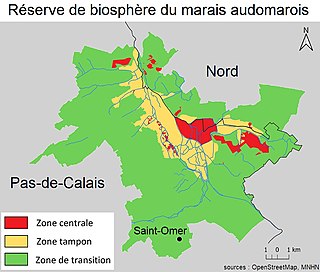Physical data
Geology and geomorphology
The Audomarois is located in the lower region of the Flemish maritime pre-plain. [1] Pale of Calais and Blootland to the north, the Lys plain to the south, Inner Flanders or Houtland to the east, and the Licques plateau to the west delimit the Audomarois natural region.

The Aa valley marks the landscape, as does the Neufossé Canal, which has linked the Lys to the Aa since 1753 and serves as a dividing line with Flanders. The Audomarois marsh was originally a depression in Clairmarais, near Saint-Omer, and is thought to have been a buttonhole excavated in the Ypresian clay by block tectonics.
The Marais Audomarois is surrounded to the west by the hills of the Haut-Pays de l'Artois, and to the east by the chain of Flanders mountains and inland "wooded" Flanders (Houtland). The hillsides are occupied by limestone grasslands near Helfaut.

Hydrographic network and water resources
Covering an area of 660 km2, the Audomarois includes 90 km of "main rivers". [2] Their final outlet is the North Sea, via the wateringues network and the remarkable semi-natural environment of the Etangs du Romelaëre, home to the Etangs du Romelaëre National Nature Reserve. The Audomarois region is mainly irrigated and drained by the Aa, a coastal river that flows into the North Sea at Gravelines.
In the Middle Ages, the port of Gravelines was the outport of Saint-Omer (itself a port town during the Carolingian sea-raising period).

The Audomarois is home to water resources that are used far beyond the Audomarois itself. It benefits from surface water (continental water mass) and two aquifers, one of which is exploitable and exploited: the Chalk groundwater mass (code 1001), the other being the Tertiary sand groundwater mass (code 1014).
Water quality and quantity assessment (2008 status) :
- Aa canalisée: In 2008, assessments of the Aa canalisée (from the confluence with the Neufossé Canal to the confluence with the Haute Colme canal) concluded that it had poor ecological potential, due in particular to poor biological status, poor physico-chemical status and a "highly modified and artificial body of water". A significant presence of PAHs has led to this section being provisionally classified as having poor chemical status. To such an extent that the Basin Committee has proposed postponing the "good ecological status" objective to 2021 (instead of 2015). [2]
- Aa-rivière and associated body of water (from the Chalk nappe; code AR02): in 2008, its ecological status was judged to be good, as were its biological and physico-chemical status. However, the hydromorphological context needs to be improved (renaturation of banks and riverbeds over at least 56 km) to "consolidate good ecological status". Its chemical status is considered poor due to the excessive presence of PAHs, probably of industrial origin. Measures to improve domestic sanitation are also proposed.
- The Romelaëre is considered to have good ecological potential and good biological and physico-chemical status.
- Groundwater (code 1001 Craie de l'Audomarois) is not considered to be overexploited, but its qualitative status is classified as "not good" in the 2008 status report. Measures to combat diffuse pollution, notably phosphorus, nitrates and pesticides, have been proposed (alternative cultivation techniques, including the use of synthetic herbicides, acquisition for exchange or renaturation in highly vulnerable areas, erosion control including the restoration of humus and grass cover in areas where groundwater is threatened, restoration of a network of hedgesand embankments perpendicular to slopes, protection and restoration of wetlands, etc.). ), but given the time required for groundwater renewal and the scale of the measures to be taken, the Basin Committee has requested a derogation from Europe, proposing to postpone the achievement of "good qualitative status" to 2027 instead of 2015.



















